GEEKOM A5 mini-PC Review: Affordable Cezanne Zen 3 at 35W
by Ganesh T S on December 8, 2023 9:15 AM ESTSystem Performance: UL and BAPCo Benchmarks
Our 2022 Q4 update to the test suite for Windows 11-based systems carries over some of the standard benchmarks we have been using over the last several years. While UL's PCMark makes the list, we have opted to temporarily suspend reporting of BAPCo's SYSmark scores (pending fixture of the energy consumption aspect). Instead, BAPCO's CrossMark multi-platform benchmarking tool has been added to the set along with UL's Procyon suite. While CrossMark employs idle time compression and processes all workloads in an opaque manner, UL's Procyon processes real-world workloads with user interactions (like BAPCo's SYSmark). We have augmented the UL Procyon suite benchmark with our own custom energy measurement setup.
UL PCMark 10
UL's PCMark 10 evaluates computing systems for various usage scenarios (generic / essential tasks such as web browsing and starting up applications, productivity tasks such as editing spreadsheets and documents, gaming, and digital content creation). We benchmarked select PCs with the PCMark 10 Extended profile and recorded the scores for various scenarios. These scores are heavily influenced by the CPU and GPU in the system, though the RAM and storage device also play a part. The power plan was set to Balanced for all the PCs while processing the PCMark 10 benchmark. The scores for each contributing component / use-case environment are also graphed below.
| UL PCMark 10 - Performance Scores | |||
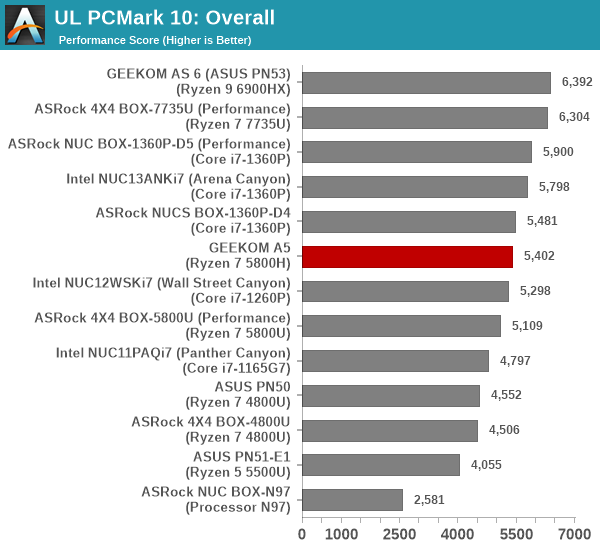
The GEEKOM A5 slots in the middle for most of the workloads, as expected. Systems based on the newer processors from both AMD and Intel deliver better performance, but the key here is the comparison between the ADL-N system and the A5. The NUC BOX-N97 has a similar form-factor and I/O list, and is priced approximately the same after taking components cost into consideration. The performance delivered by the A5 is more than double that of the NUC BOX-N97 for the usual consumer workloads tested in PCMark 10.
UL Procyon v2.1.544
PCMark 10 utilizes open-source software such as Libre Office and GIMP to evaluate system performance. However, many of their professional benchmark customers have been requesting evaluation with commonly-used commercial software such as Microsoft Office and Adobe applications. In order to serve their needs, UL introduced the Procyon benchmark in late 2020. There are five benchmark categories currently - Office Productivity, AI Inference, Battery Life, Photo Editing, and Video Editing. AI Inference benchmarks are available only for Android devices, while the battery life benchmark is applicable to Windows devices such as notebooks and tablets. We presents results from our processing of the other three benchmarks.
| UL Procyon - Office Productivity Scores | |||
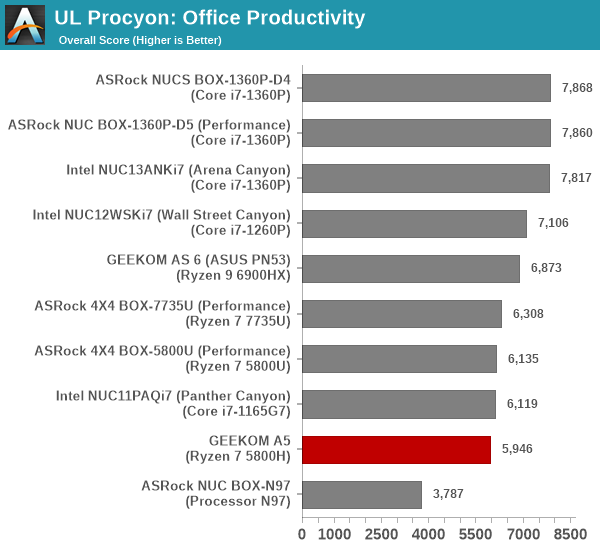
The A5 performs similar to the other Cezanne systems in the Office workloads, but it is towards the end of the pack, as some of the older systems against which the A5 performed well in PCMark 10 were not subject to the UL Procyon workloads.
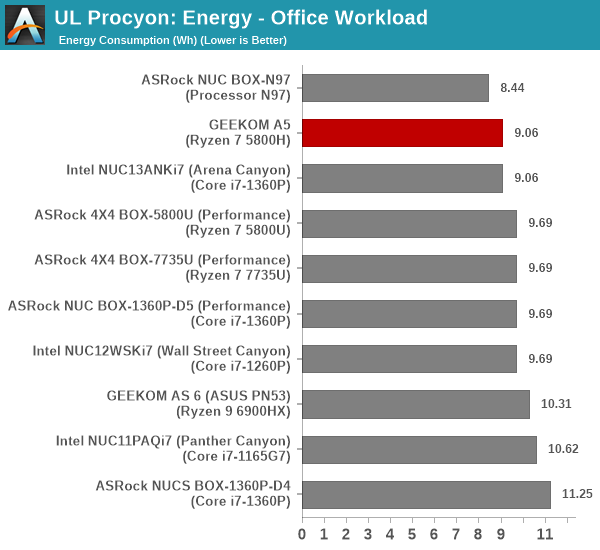
From an energy consumption viewpoint, the A5 is similar to the Intel NUC (Arena Canyon). Though the jobs take a longer time to finish in the A5, the system is quite power efficient. Only the NUC BOX-N97 (with a much lower performance) is more energy efficient compared to the A5.
Moving on to the evaluation of Adobe Photoshop and Adobe Lightroom, we find that the GPU is utilized more heavily compared to the office workloads. This allows the A5 to move up a notch, but it still remains in the bottom half of the pack.
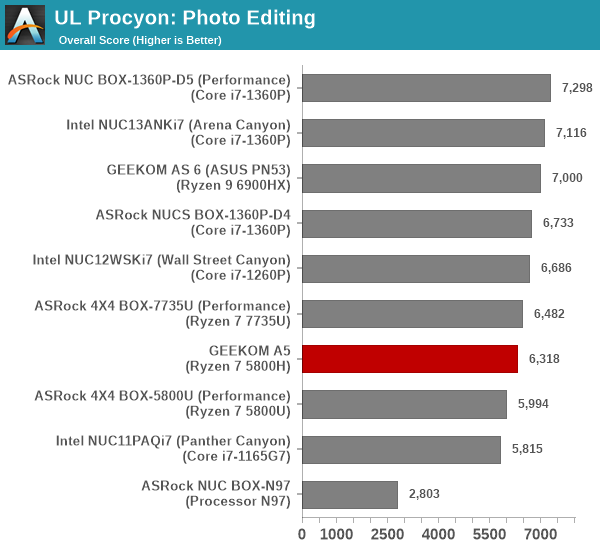
Fortunately, the power efficiency allows it to be among the most energy efficient systems for the photo processing workload.
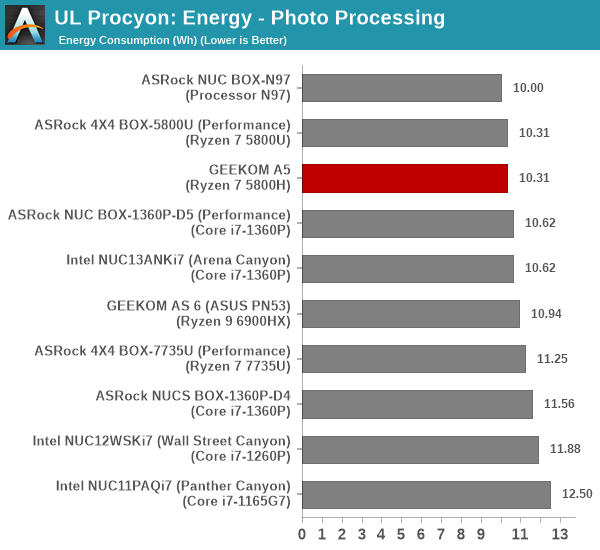
UL Procyon evaluates performance for video editing using Adobe Premier Pro.
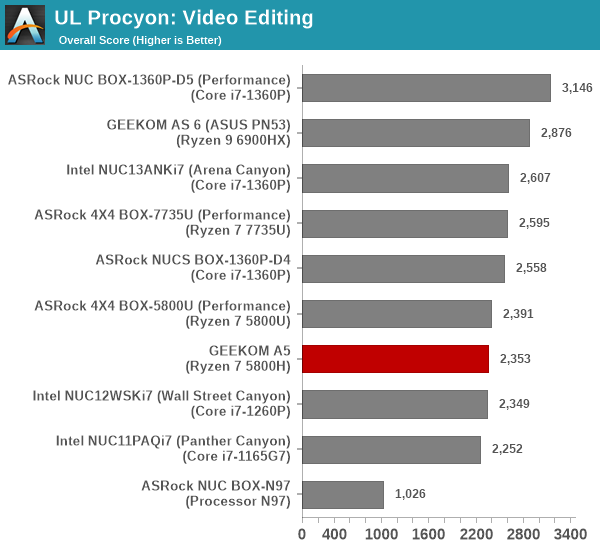
The video editing scores depend on the GPU capabilities and the available power budget. It is no surprise that the newer generation processors with iGPU improvements have a lead over the A5.

Stressing the iGPU weans away a bit of the power efficiency for the task, but the A5 still delivers slight benefits over the Cezanne systems evaluated back in 2021.
BAPCo CrossMark 1.0.1.86
BAPCo's CrossMark aims to simplify benchmark processing while still delivering scores that roughly tally with SYSmark. The main advantage is the cross-platform nature of the tool - allowing it to be run on smartphones and tablets as well.
| BAPCo CrossMark 1.0.1.86 - Sub-Category Scores | |||
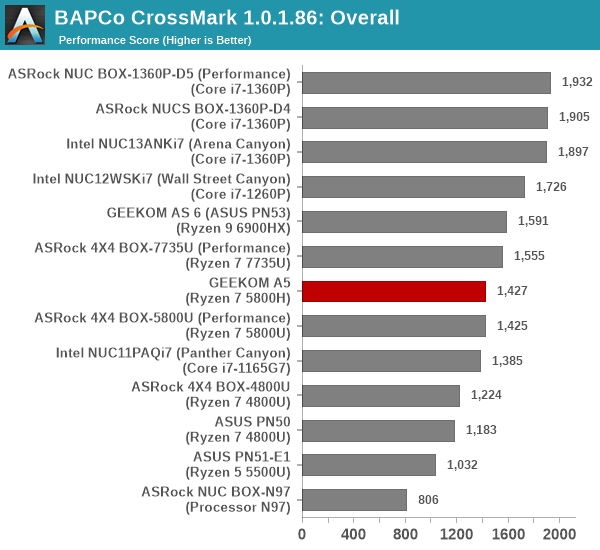
The A5 loses out a bit on the responsiveness front, as most of the other systems are equipped with Gen4 SSDs. As we shall see later, the A5's Ryzen SoC is configured for a 60W / 42W / 35W operation mode (similar to the PL1 / PL2 of the Intel systems). Since CrossMark workloads involve idle time compression, the short bursts of higher power help the A5 move towards the middle of the pack in the productivity and creativity workloads.










35 Comments
View All Comments
t.s - Friday, December 15, 2023 - link
Yes. Inferior, yet pricier than AMD counterpart.sjkpublic@gmail.com - Saturday, December 9, 2023 - link
All I see here is outdated hardware. Gen3 and not Gen4 or better. No USB 4. Etc. Great unit if you are placing it in a Mall display.FWhitTrampoline - Sunday, December 10, 2023 - link
An ASRock X300 Desk Mini with an STX/AM4 MB and Ryzen 5700G can be had for a little over $320 and the X300 Desk Mini comes with 2, M.2 x4 PCIe link slots and space for 2 SATA internal SSDs. And one of the M.2 slots can be fitted with an M.2 to OCuLink adapter and there's plenty of Knockouts on the X300 Desk Mini's case to rout the OCuLink cable out of the case easily sans any need to open the case afterwards. So with Knockouts on the case for an optional OEM 2 USB port kit or other knockout some OCuLink port could be retrofitted is one gets creative!Reflex - Monday, December 11, 2023 - link
As an owner of a MiniITX board with a 5700G I regret to inform you that external PCIe lanes only run at x3 with that CPU, even for storage. So while on paper that X300 looks better than this mini box, in practice it's got the same limitation. The 5700G is overall not quite as powerful as this mini box at equivalent wattages, although thanks to being an ITX sysem I run mine at 65W which likely outperforms this box substantially.FWhitTrampoline - Tuesday, December 12, 2023 - link
The M.2 PCIe Lanes on processor side of the Board is listed as PCIe 3.0 X4 lanes while the M.2 on back side of the MB limited to what's listed so not according to ASrock's specifications page for the X300 Desk Mini:- 2 x SATA 6Gb 2.5-inch 7mm/9.5mm Hard Drive (RAID 0/1)
- 1 x Ultra M.2 (2280) PCIe Gen3 x4 SSD Slot
- 1 x Ultra M.2 (2280) Slot
- PCIe Gen3 x4 (Renoir, Picasso and Raven Ridge APU)
- PCIe Gen3 x2 (Athlon 2xxGE series APU)
t.s - Friday, December 15, 2023 - link
And what Gen3 that not enough for you that you have to use Gen4? As for USB4, I agree. And you can get it if you buy mini-pc with ryzen 6800u/h or 7735H.Schugy - Sunday, December 10, 2023 - link
That non-USB-C PSU brick must be a joke.lmcd - Monday, December 11, 2023 - link
Depending on your USB controller as part of the lone source of power is an anti-feature in my opinion. With laptops it's different because there's a battery, but USB-C desktop power is a "no thanks."meacupla - Monday, December 11, 2023 - link
It's a standard, and really cheap, 19V laptop power brick.Finding a cheap USB-C charger than can output >120W over a single port is a challenge, unfortunately. Most of them top out at 100W per port.
200W and 240W PD cables have been available for at least 6 months, but no such charger has shown up yet.
stephenbrooks - Monday, December 11, 2023 - link
The brick is nearly as large as the PC.